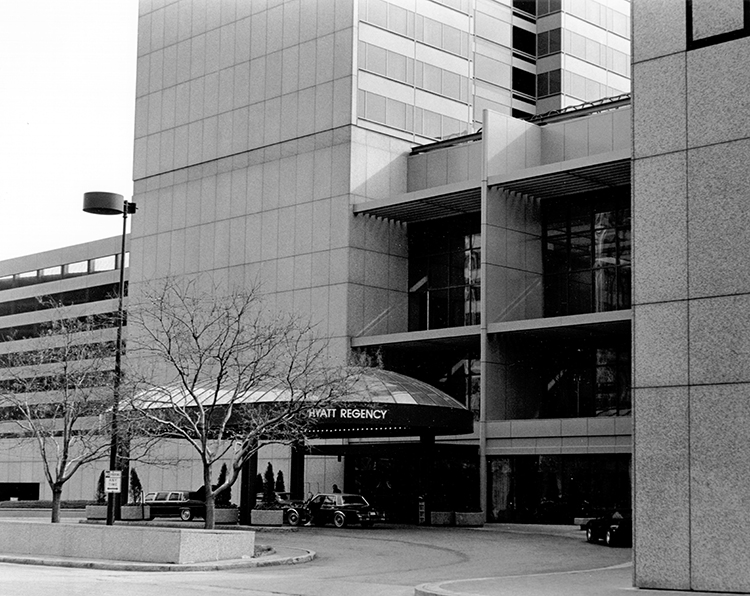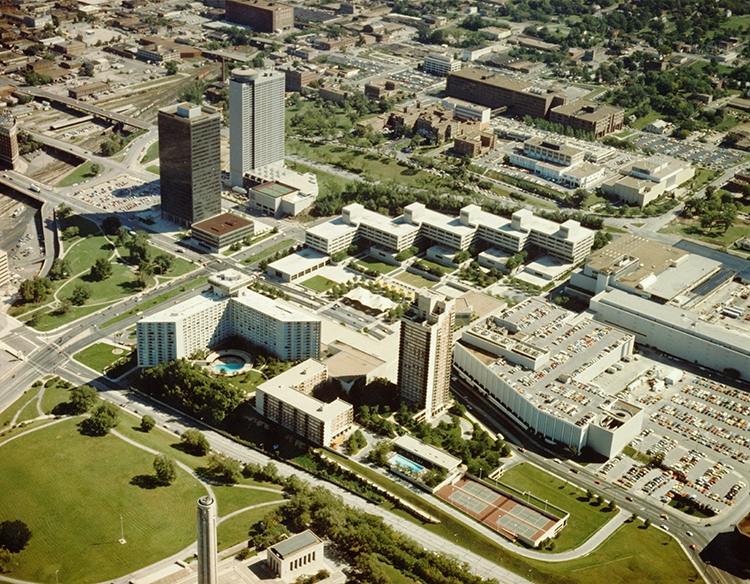On the evening of July 17, 1981, 2,000 dancers gathered in the atrium of the Hyatt Regency Hotel to partake in one of the regular "tea dances," which had become a local tradition over the previous year since the luxurious hotel had opened. Dozens had gathered on three walkways suspended from the ceiling so that they could observe the festivities below. At 7:05 p.m., two of these 32-ton walkways suddenly collapsed onto the dancers below. The disaster resulted in 114 deaths, 200 additional injuries, and as many unanswered questions from the victims' families and the survivors of the tragedy.
Construction on the Hyatt Regency Hotel had begun in 1978. It was located in the Crown Center commercial complex, which was then revitalizing a run-down part of the city near Union Station. With its revolving restaurant, a large atrium, an exhibit hall, conference facilities, and more than 700 guest rooms, the hotel contributed to the ritzy environment of Crown Center. At 40 stories tall, the Hyatt Regency would be the tallest building in the state of Missouri until 1986. After it opened in July, 1980, its regularly-held tea dances attracted thousands of visitors to the area.
Signboard Hill before the Crown Center development.
After just one year, however, the tragic walkway collapse marred Kansas City's new attraction. As thousands in the atrium swing-danced to the song, "Satin Doll," on July 17, 1981, the fourth-floor walkway, along with the second-floor walkway that was suspended from it, collapsed without warning. Survivors later reported a brief period of awed silence following the collapse. Screams and general panic then spread as the dancers took in what had just happened. First responders worked throughout the night to recover the hundreds of victims who were trapped under the wreckage of the walkways.
A subsequent investigation uncovered serious design flaws that resulted from miscommunication between the engineering firm, Jack D. Gillum and Associates, and the Havens Steel construction company. The original design had called for sets of support rods to suspend the fourth and second floor walkways from the ceiling. Instead, the designs were changed so that a second set of rods hung the second floor walkway from the fourth floor walkway. This arrangement made the upper walkway support its own weight as well as the weight from the walkway below instead of suspending all of the weight directly from the stronger ceiling supports.
The completed Crown Center site.
Finally, the rods holding the walkways were bolted into a box beam so that only a small nut and washer held the walkways to each rod. When the walkways collapsed, the rods had simply ripped through the walkways' box beams. Investigators noted that this design was far below Kansas City's existing building codes, yet it had passed inspection. In fact, the National Bureau of Standards later declared that the walkways could barely have supported their own weight, much less the weight of dozens of people.
As a result of the disaster, the engineers who had signed off on the plans lost their licenses. Jack D. Gillum and Associates also lost its engineering license, although no criminal charges were filed. The Kansas City Times and The Kansas City Star, then jointly-owned and operated, won a Pulitzer Prize for their outstanding coverage of the collapse, the aftermath, and the investigation. The Crown Center Redevelopment Corp., the owner of the hotel, paid over $140 million in legal claims to the victims or their families. And of course, the lives of thousands of friends and families of the victims were forever altered.
The final legacy of the walkway collapse is still undetermined. Among the thousands of people who were affected, many just wanted to forget the accident and move forward. Others want to be sure that the lessons learned from the collapse were not forgotten by engineers or the general public. Measured by loss of life, the event stands as the worst structural failure in American history. There is currently no memorial to honor the victims and those who responded to the catastrophe, and hotel guests can pass through the atrium without ever learning of what happened there. To fulfill this need for commemoration, the Skywalk Memorial Foundation, Inc. is working with the city to raise funding for such a memorial.
View image associated with the Hyatt Regency Hotel that are a part of the Missouri Valley Special Collections:
- Hyatt Regency Hotel, 1989.
- Aerial View of Downtown Kansas City, with Crown Center visible in the foreground; before the construction of the Hyatt Regency Hotel.
- Crown Center, with the Hyatt Regency visible; second to the left, 1985.
- Aerial view of Crown Center, including the Hyatt Regency, 1985.
- Downtown Skyline, 2001.
Check out the following books about the Hyatt Regency disaster held by the Kansas City Public Library:
- Kansas City: An American Story, by Rick Montgomery and Shirl Kasper; contains a pictorial explanation of the disaster, pp. 336-338.
- Failed Technology: True Stories of Technological Disasters, by Fran Locher Freiman; focusing on engineering failures of the twentieth century.
- Fantastic Feats and Failures, published by the Kids Can Press; intended to introduce younger readers to notable engineering successes and failures, including the Hyatt Regency walkway collapse, pp. 14-15.
- Catastrophe!: Great Engineering Failure - and Success, by Alfred B. Bortz; also intended for younger readers, includes information about the Hyatt Regency walkway collapse.
Continue researching the Hyatt Regency disaster using material held by the Missouri Valley Special Collections:
- Compilation, Hyatt Regency Skywalk Collapse; a collection of newspaper clippings.
References:
Rick Montgomery, Shirl Kasper, Kansas City: An American Story (Kansas City, MO: Kansas City Star Books, 1999), 336-338.
Dirk Johnson, "For Many, a Memorial Long Overdue," Kansas City Journal (July 27, 2008).
William Earl Parrish, ed., A History Of Missouri: 1953 to 2003 (Columbia, MO: University of Missouri Press, 2004), 77-78.
SUBMIT A QUESTION
Do you want to ask a question for a future voting round? Kansas City Star reporters and Kansas City Public Library researchers will investigate the question and explain how we got the answer. Enter it below to get started.




